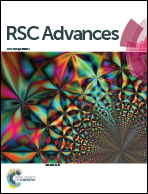Enhancement of electrical conductivity, dielectric anisotropy and director relaxation frequency in composites of gold nanoparticle and a weakly polar nematic liquid crystal†
Abstract
We report complex permittivity characteristics in composites of gold nanoparticles (GNP) and a weakly polar nematic liquid crystal possessing a low frequency director relaxation. Differential calorimetric measurements show that the inclusion of GNP has a strong influence on the isotropic–nematic (fluid–orientational fluid) transition temperature as well its first order character in terms of the transition entropy. The absolute value of conductivity increases by two to three orders of magnitude with respect to that for the host liquid crystal and its concentration dependence is demonstrated to be described by the percolation scaling law generally observed in composites of metal particles and polymers. However, the obtained exponent is much smaller, possibly owing to thermal fluctuations present in the fluid-like nematic medium. The activation energy governing the temperature dependence of conductivity is much higher in the nematic than in the isotropic phase. The frequency dependence of the ac conductivity exhibits a critical frequency that is concentration-dependent, but the exponents obtained defy Jonscher's Universal Response principle. A surprising feature is the observation of a substantial increase of not only the principal permittivity values, but their anisotropy as well. These studies also constitute the first report on the influence of GNP on the director relaxation mode of nematics. In contrast to the behaviour of the static permittivity, the dynamics of the system as measured using the director relaxation is seen to become faster with the presence of GNP. We provide an explanation for this antagonistic behaviour in terms of the alignment of the liquid crystal molecules in the vicinity of GNP, and the importance of the weak polarity of the liquid crystals used.


 Please wait while we load your content...
Please wait while we load your content...